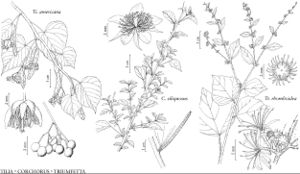Tilia
Sp. Pl. 1: 514. 1753.
Gen. Pl. ed. 5, 230. 1754.
| Taxon | Illustrator ⠉ | |
|---|---|---|
 | Tilia americana Corchorus siliquosus Triumfetta rhomboidea | Barbara Alongi Barbara Alongi Barbara Alongi |
Trees to 150 (–300+) dm. Leaves deciduous, distichous; stipules caducous; petiole not winged; blade mostly ovate to orbiculate, base cordate to truncate, usually asymmetric, sometimes caducous. Flowers actinomorphic; sepals valvate, bases sometimes coherent, abaxially hairy [glabrous], adaxially usually densely pilose to villous; petals cream to yellow, lanceolate to oblanceolate; stamens usually in 5 fascicles [+ 5 separate stamens]; staminodes [0–] 5, similar to, smaller than, petals; ovary sessile, (3–) 5-carpellate, ultimately 1-celled; styles 1 per ovary; stigmas 5-lobed. Fruits nutlike, indehiscent. x = 41.
Distribution
North America, Mexico, Europe, Asia, mostly temperate areas
Discussion
Species ca. 20 (1 in the flora).
Tilia (Tiliaceae) has been moved into Malvaceae in a broad sense (see Angiosperm Phylogeny Group 1998, 2003, 2009, and http://www.mobot.org/MOBOT/Research/APweb/welcome.html).
The name basswood evidently derives from bast (the inner bark), which is a source of fibers used in making cords and ropes from tilias. The names linden and lime tree may be English derivatives from German (linde baum). Tilias are commonly planted as shade trees along paths and streets; a potential problem with such plantings is aphid rain of honeydew, usually followed by sooty molds. Some living tilias are thought to be more than 300, possibly 1000+, years old and some have trunk diameters to two or more meters. Tilia wood is fine-grained and has long been prized by carvers. Flowers, fruits, and wood from tilias are used by herbalists and in perfumery. Nectar from tilia flowers is used by bees in making honey; some reports suggest the nectar may sometimes be poisonous to bees.
For native tilias in the flora area, 50+ specific and infraspecific basionyms have been published; the proposed taxa have been distinguished largely on differences in indument on leaves. Leaf surfaces that look to be glabrous at magnifications of 1–10× are usually found, at 30× or higher magnification, to have minute glandular hairs (0.05–0.1 mm); such surfaces are called glabrate here. More readily seen hairs on tilia leaves are simple, forked, fascicled, or stellate (see J. W. Hardin 1990). Indument on leaves of flowering shoots of tilias may differ from tree to tree within a population, may differ within trees on shoots in full sun versus relatively shaded shoots, and may differ on a single leaf from early season to late season. Leaves on vegetative
sucker shoots from at and near bases of tilia trunks are usually larger and thinner than leaves on flowering shoots. H. Kurz and R. K. Godfrey (1962) noted in their review of the taxonomy of tilias that a “student of Tilia” identified as distinct species individual specimens from different parts of a single tree.
W. C. Ashby (1964) studied leaf induments and other traits in specimens from wild-collected tilias and from tilias grown from seed in common gardens. Ashby concluded that native tilias in an area ranging from North Dakota to Illinois and thence to Massachusetts and North Carolina belong to one species.
L. G. Hickok and J. C. Anway (1972) sampled 102 populations of tilias from two Canadian provinces and 17 of the United States for 32 morphological characters (151 specimens) and for flavonoid chemistry (92 leaf samples). They noted geographical trends in induments and flavonoid patterns; they did not find justification for recognizing more than one native species of Tilia in the flora area.
[Editorial note added in proof: Molecular data support the existence of two discrete genetic lineages of North American Tilia. One includes most Mexican haplotypes and those from the southern Appalachians, while the second includes most exemplars from the United States and two haplotypes from eastern Mexico (D. McCarthy 2012).]
Non-native tilias that may be encountered in the flora area outside of cultivation as ruderals or abandoned plantings include: Tilia cordata Miller (leaf blades orbiculate, 4–7 cm, abaxially glabrate but for tufts of hairs at vein axils; fruits not notably ribbed; European), T. platyphyllos Scopoli (leaf blades ovate to orbiculate, 7–10 cm, abaxially sparsely stellate-hairy and with tufts of hairs at vein axils; fruits notably 3–5-ribbed; European), and T. tomentosa Moench (including T. petiolaris de Candolle with pendulous branches; leaf blades suborbiculate, 7–13 cm, abaxially usually densely white stellate-hairy; fruits weakly five-angled; Eurasian). Tilia ×europaea Linnaeus evidently applies to hybrids derived from crosses between T. cordata and T. platyphyllos.
Tilia glabra Ventenat is a superfluous name; T. americana Linnaeus was cited as a synonym. Tilia michauxii Nuttall was a provisional name and was not validly published. Tilia pubescens Aiton is a superfluous name; T. caroliniana Miller was cited as a synonym.
Selected References
None.
Lower Taxa
"dm" is not declared as a valid unit of measurement for this property.